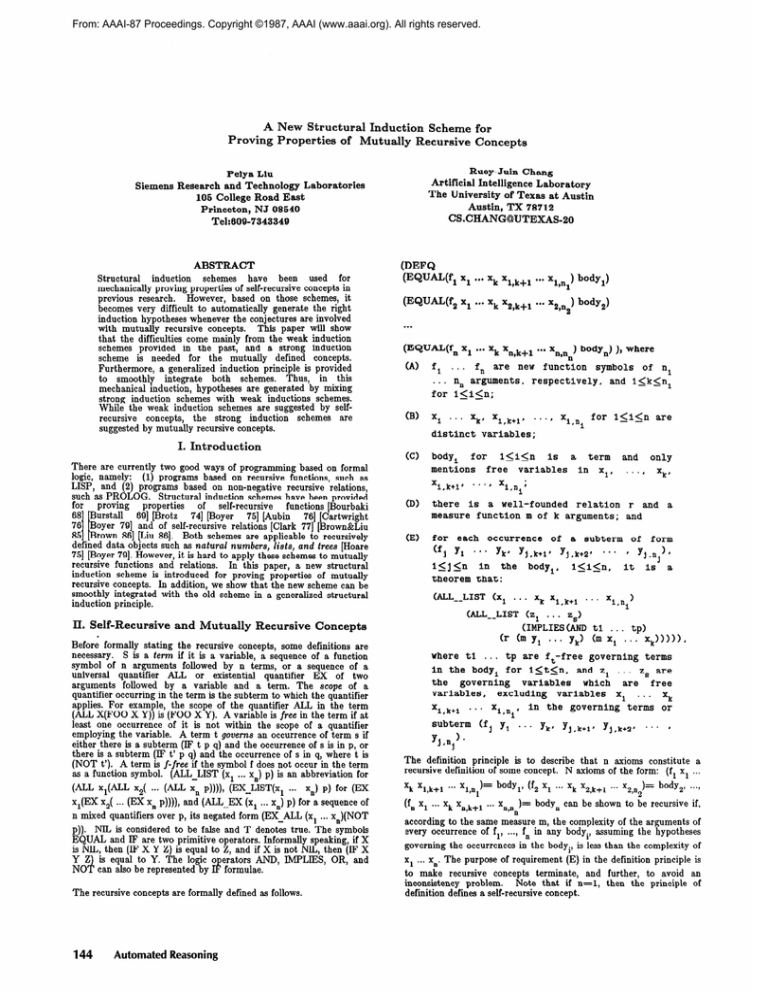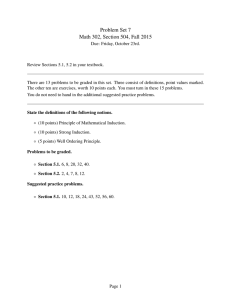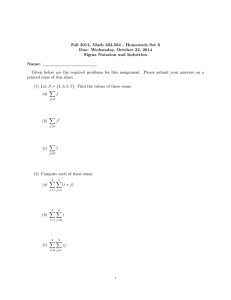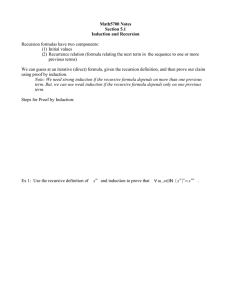
From: AAAI-87 Proceedings. Copyright ©1987, AAAI (www.aaai.org). All rights reserved.
Induction Scheme
A New Structural
Proving Properties of Mutually Recursive
Ruey-Juin Chang
Peiya Liu
Siemens Research and Technology Laboratories
105 College Road East
Princeton, NJ 08640
Te1:609-7343349
ABSTRACT
schemes
have
been used for
Structural
induction
mechanically proving properties of self-recursive concepts in
previous research.
However, based on those schemeq, it
becomes very difficult to automatically
generate the right
induction hypotheses whenever the conjectures are involved
This paper will show
with mutually recursive concepts.
that the difficulties come mainly from the weak induction
schemes provided in the past, and a strong induction
scheme is needed for the mutually defined concepts.
Furthermore,
a generalized induction principle is provided
to smoothly
integrate
both schemes. Thus, in this
mechanical induction, hypotheses are generated by mixing
strong induction schemes with weak inductions schemes.
While the weak induction schemes are suggested by selfrecursive
concepts,
the strong induction
schemes are
suggested by mutually recursive concepts.
I. Introduction
for
Concepts
Artificial
Intelligence Laboratory
The University of Texas at Austin
Austin, TX 78712
CS.CHANGOUTEXAS-20
(DEFQ
(EQUfi&
X1 0.. Xk Xl,k+l
(EQUAL(fi
-0. X1 n ) body11
x1 . . . xk x~,~+~ . . . I~‘~‘)
'2
body,)
...
(EQUAL(f,,
x1 . . . xk x~,~+~ . . . x~,~ ) bodyJ
n
(A>
f,
. . . f, are new function
. . . nn arguments,
respectively,
for l<i<n;
(B)
x1 * * * Xk’ xI,L+I# . *. , Xi+
distinct
(c-3
symbols
of ni
and l<k<_ni
for
a
in
’- *’ Xi,ni;
there
is a well-founded
relation
measure function
m of k arguments;
(E)
for
each
71
l<lln
theorem
are
and only
. . . , xk,
term
x1,
(D)
(fj
l<i<n
variables;
for
l<i<n
is
body i
mentions
free
variables
Xi,k+la
), where
occurrence
’ * ’
yk’
in
the
that:
(ALL--LIST
Yj,k +l’
of
a
subterm
Yj,k +2#
bodyi,
-*
l<i$r,
(x 1 . . . xk xi k+i
,
r and
and
of
-
l
it
a
form
Y,,n
Is
) l
1
a
. . . xi n >
' i
(ALL--LIST
Before formally stating the recursive concepts, some definitions are
necessary.
S is a term if it is a variable, a sequence of a function
symbol of n arguments followed by n terms, or a sequence of a
universal
quantifier
ALL or existential
quantifier
EX of two
arguments
followed by a variable and a term. The scope of a
quantifier occurring in the term is the subterm to which the quantifier
applies. For example, the scope of the quantifier ALL in the term
(ALL X(FO0 X Y)) is (FOO X Y). A variable is free in the term if at
least one occurrence of it is not within the scope of a quantifier
employing the variable. A term t governs an occurrence of term s if
either there is a subterm (IF t p q) and the occurrence of s is in p, or
there is a subterm (IF t’ p q) and the occurrence of s in q, where t is
(NOT t’). A term is f-free if the symbol f does not occur in the term
as a function symbol. (ALL-LIST (x1 ... xn) p) is an abbreviation for
(ALL xl(ALL x2( .. . (ALL xn p)))), (EX-LIST(xr ... xn) p) for (EX
xr(EX x2( . . . (EX xn p)))), and (ALL-EX (x1 ... xh) p) for a sequence of
n mixed quantifiers over p, its negated form (EX-ALL (x1 . .. x,)(NOT
p)). NIL is considered to be false and T denotes true. The symbols
EQUAL and IF are two primitive operators. Informally speaking, if X
is NlL, then (lF X Y Z) is equal to Z, end if X is not NIL, then (IF X
Y Z) is equal to Y. The logic operators AND, IMPLIES, OR, and
NOT can also be represented by IF formulae.
The recursive concepts are formally defined as follows.
144
Automated Reasoning
(z, . . . zs>
(IMPLIESUND t1 . . . tp)
(r b yi . . . yk) Cm xi . . . ~~11111,
where tl . . . tp are f,-free
governing
terms
in the body, for l<t$r,
and zi . . . zS are
the
governing
variables
which
are
free
variables,
excluding
variables
x1 . . . xk
terms or
Xi,k+l . -* Xl,ni' in the governing
subterm
cfj
Yi
. . . yk’ yj,k+l’
yj,k+2a
...
#
The definition principle is to describe that n axioms constitute a
recursive definition of some concept. N axioms of the form: (fl x1 ...
‘k
)=
'l,k+l "- 'l,nl
body,,
(f2 x1 . .. xk ~~,~+r ... x2 n )= body,,
.. . .
(f, x1 . . . xk ~~,~+r .. . xnn )= bodyn can be shown to ie recursive if,
‘n
according to the same measure m, the complexity of the arguments of
every occurrence of f,, ... . f, in any bodyi, assuming the hypotheses
governing the occurrences in the body,, is less than the complexity of
x1 .. . xn. The purpose of requirement (E) in the definition principle is
to make recursive concepts terminate,
and further, to avoid an
then the principle of
inconsistency problem. Note that if n=l,
definition defines a self-recursive concept.
Example
(DEFQ
QO:
In the predicate (QS0RT.R Z Wl W2), Z is an input list and the
output is the difference list of Wl and W2, which is an ordered list
Z. The QS0RT.R could be added to the system because (ALL Z(ALL
Wl(ALL
W2(ALL
X (ALL Y&ALL V(IMPLIES(AND(LISTP
Z)(PART(CDR
Z)(CAR Z) X Y))(PLESSP(LENGTHl
X WI
(CONS(CAR Z)) V)(LENGTHl
Z Wl W2))))))))) and (ALL Z(ALL
Wl(ALL
WZ(ALL
X (ALL Y(ALL
V(IMPLlES(AND(LISTP
Z)(PART(CDR
Z)(CAR Z) X Y))(PLESSP(LENGTHl
Y V W2)
V)(LENGTHl Z Wl W2))))))))) hold.
(EQUAL(EVAL L ENVRN)
(IF(LISTP L)
(APPLY.suTm (CAR L)
(E~AL.LIST(CDR L) EN’WW >
L))
(EQUAL(EVAL.LIST L ENVRN)
(IF(LISTP L)
(CONSGVAL(CAR L) ENVRN)
(EVAL.LIST(CDR L) ENVRN))
NIL) 11
In example QO above, mutually recursive concepts will be admitted
the following instantiation of our definition principle.
III. A Generalized
by
EVAL.LIST.
(B) x1 is L, x2 is ENVRN, k is 2, n is 2, nl is 2, and n2 is 2.
(C) body1 is the term (IF(LISTP L) (APPLY.SUBR
(CAR L)
L) ENVRN)) L), and body, is the term
(IF(LISTP
L)
(EVAL.LIST(CDR
(CONS(EVAL(CAR
L) ENVRN)) NIL).
L)
ENVRN)
W’) r is PLESSP and m is (LENGTH1
L ENVRN), where
(LENGTH1 L ENVRN) is defined to be (LENGTH L).
LENGTH is a primitive function for counting the elements
in L.
(El The following theorems
are required
in the definition
principle:
e For an occurrence (EVAL.LIST(CDR L) ENVRN) in
the body of function EVAL, the governing term is
(LISTP
L).
It is a theorem
that
(ALL
L(lMPLIES(LISTP
L)(PLESSP(LENGTH(CDR
L))
(LENGTH L)))).
Principle
Essentially
mechanical
induction
reasoning
works because the
similarity could be contrived between the structures of the recursive
definition functions and of the induction schemes. The structures of
recursive functions serve as templates for automatically generating the
suitable induction hypotheses to prove a conjecture involved with
those recursive functions. However, there is often no structure
similarity between mutually recursive functions and weak induction
schemes provided in previous research.
The finite number of
hypotheses are needed to be specified explicitly in the weak induction
schemes.
Using these weak induction schemes often results in the
generation of useless induction hypotheses for the conjecture involved
with mutually recursive functions.
A strong induction form will be
shown to be needed and can be generated from the structures of
mutually recursive concepts.
In the strong induction schemes, the
finite number of hypotheses are implicitly described by particular
recursive concepts.
An example will illustrate the problem in using weak induction
schemes for hypothesis generation.
Suppose we try to prove the
conjecture (ALL L(EQUAL L(FO0 L))), where the mutually recursive
functions are defined as follows.
(DEFQ
(EQUAL.(FOO L)
(IF(LISTP L)
(CONS(CAR L) (FOOLIST(CDR L)))
L))
(EQUAL(FOOLIST L)
(IF(LISTP L)
(CONS(FOO(CAR L)) (F~OLIST(CDR ~1))
L)))
o For an occurrence (EVAL.LIST(CDR L)ENVRN) in
the body of function EVAL.LIST, the governing
term is (LISTP L). It is a theorem that (ALL
L(IMPLlES(LISTP
L)(PLESSP(LENGTH(CDR
L))(LENGTH L)))).
Let (p L) be the term (EQUAL L FOO L)). In the weak induction
schemes, the instantiated terms of Ip L) as induction hypotheses are
required to be explicitly described.
Thus, the induction hypothesis,
based on the weak induction scheme and the structure of (FOO L).
o For an occurrence (EVAL(CAR L)ENVRN) in the
body of function (EVAL.LIST L ENVRN), the
governing term is (LISTP L). It is a theorem that
(ALL L(IMPLlES(LISTP L)(PLESSP(LENGTH(CAR
L))(LENGTH L)))).
term (p L) in the proof by. induction, it will not look iike
counterpart in the hypotheses, and the hypotheses will be useless.
Suppose that (PART L C Ll L2) is true if Ll is a list of elements of L
less than C, and L2 is a list of the rest of L. For example, suppose C is
6 and L is a list (2 6 3 9 lo), then Ll is (2 3) and L2 is (6 9 10). The
quick sort concept could be defined as follows.
Example
Induction
A. Why Strong Induction Schemes are Needed
(4 f, is the function symbol EVAL; f9 is the function symbol
(EVAL.LIST(CDR
Structural
Ql:
(DEFQ
(EQ~~(Qs~RT.R z wi w2>
(IF(LISTP Z>
ax xm
Y(IF(PART(CDR z) mm
z> x Y)
(M V(IF(QS0RT.R X WI (CONS(CAR Z> VI>
(QSORT.R Y v w2)
NIL))
NIL)))
(EQUAL wi w2))))
Even if we change these functions into a self-recursive function
an extra argument S as follows, our problem still exists.
its
with
(DEFQ
(EQU~~+(FOOS L s)
(IF(EQUAL s 0)
(IF(LISTP L)
(CONS (CAR L) (FOOS(CDR L) I>>
L)
(IF(EQUAL s 11
(IF(LISTP L)
(CONS(FOOS(CAR L) 0) (FOOS(CDR L) 1))
L)
NIL))))
Liu and Chang
145
An induction scheme, following the weak induction principle, for the
conjecture (ALL L(EQUAL L(FOOS L 0))) will be generated as (ALL
LW'LWAWLISTP
L)WWP
(CDR WP
(Cm W
(P W,
where (p L) is the term (EQUAL L(FOOS L 0)). In the base case, we
need to prove (ALL L(lMPLIES(NOT(LISTP
L))(p L))). However, if
we open the term (FOOS L 0) in the conclusion (EQUAL LrFOOS L
O)!, it will also not.look like its counterpart in thk hypothe&.
Often
this type of redefined self-recursive functions is hard to suggest right
induction hypotheses in weak induction schemes, due to its unnatural
recursion characteristics
and certain sensitive switch arguments
irrelevant to the measured arguments on which functions recurse. In
this example, what is really needed in the hypothesis is the term
(AND(LISTP L) (FOOLIST-IND (CDR L))), where (FOOLIST-IND L)
and (FOO-IND L) are mutually defined as
(EQUAL(FOO-IND L)
(IF(LISTP L)
(F~~LIsT-IND (CDR L))
T)), and
(EQuAL(FooLIST-IND L)
(IF(LISTP L)
(AND (p(C;4RL)) (FOOLIST-IND (CDR ~1))
T)).
Intuitively, the term (AND (LISTP L)(FOOLIST-IND (CDR L))) is
actually ANDing the terms (LISTP L), (p (CAR (CDR L))), .. .. (p
CADDDD...R L)) together by recursively opening up the term
FOOLIST-IND (CDR L)). Th us, this hypothesis implicitly represents
a series of instantiated conjectures and this induction form is actually
a strong induction scheme.
More importantly,
there is an obvio&
structural similarity between (FOO L) & (FOOLIST L) and (FOOIND L) & (FOOLIST-IND
L). Later on, we will give detailed
descriptions of automatically
cdnstructing the terms (FaOLIST-IND
L) and (FOO-IND L) from mutually recursive concepts. (FOOLISTIND (CDR L)) is obtained from the body of (FOO-IND L) since (FOO
L appears in the conjecture, and the corresponding term (FOO-IND
L suggests the possible induction hypotheses from the recursive
structure of its body.
B. A Comparison
Schemes
Between
Weak
C. Hypothesis
Terms
Intuitively,
hypothesis
terms are those terms allowable to be
instantiated
as hypotheses in the strong induction schemes. These
terms are quite powerful. They can implicitly represent a series of
induction
hypotheses
in mechanical
induction
proof about the
properties of mutually recursive concepts. A formal definition of
hypothesis terms is described as follows. A subterm is a call of f in
the term s if the subterm beginning with the function symbol f occurs
in the term s. (P1 x1 .. . xII x”+~ . .. xJ, .. .. (Pd x1 . .. xI1x~+~ . .. xt) are
the hypothesis terms of f,, . .. . fd with P, replacing f,, . ... fj l<j<cl,
-if
1. f,, . ... fd are the following mutually recursive functions
based on a well-founded relation R and a measure function
M of n arguments,
(EQUAL(fl xi . . . xn x~+~ . . . x,> body&
(EQUAL(f2 xi .. . xn x~+~ . . . xt> body&
. ..,
(EQUAL(fd xi . . . xn x~+~ .. . x,> bodyd);
2. (PO x1 . .. xn, xn+l . .. xt) is a term; and
3. (P1 x1 . .. xn xn+l . .. xJ, . . .. (Pd x1 . .. xn x~+~ .. . xt) are
obtained in the following way.
(EQUAL(Pi x1 . .. x,,x~+~ . . . x,) body'&
(EQUAL(P2 x1 . . . xn x,,+~ .. . xt> body'&
. . .,
(EQUAL(Pd x1 . . . xn x~+~ . .. x,> body'&
where
body’i=(HT
recursively
body,)
for
On the other hand, in the strong induction scheme, we prove that a
certain property (P X) holds for all X by considering two cases. In
the first case, called the base case, we show that (P X) holds for all
nonpair objects X. However, in the induction step, we assume that X
is a pair and that (P (CAR X)), (P (CADR X)), .. . . and (P(CADDD .. .
R X)) hold, and prove that (P X) holds. In other words, the induction
step shows that if X has the desired property up to an arbitrarily
given point, then it also has the property at the next higher point. For
the convenience of mechanical induction, this series of hypotheses is
represented as a recursive concept (Q X) defined to be (IF(LISTP
X)(AND(P(CAR
X))(Q(CDR X))) T). In the FOO example, we
represent the hypothesis as (AND(LISTP X) (P*2 (CDR X )), where
(P*2 X) is defined to be (IF(LISTP X)(AND(p (CAR X)) 1P*2(CDR
X))) T). In the next section, we will show that the hypothesis can
automatically
be generated from mutually recursive functions by
examining their structures.
HT
is
a. Suppose the term s has the form (ALL-EX(z)
then (HT s)=(ALL-EX(z)(HT
v)).
v),
b. Suppose the term s has the form (IF c u v).. Then
(HT s)=(IF c (HT u)(HT v)) if the term c is fcfree,
l<i$l;
C. Suppose
(HT s)=(IF (HT c)(HT u)(HT v)) otherwise.
the term
s is fcfree,
l<i<d,
then
(HT
s)=T.
a. Suppose s’ is a term obtained
by replacing every
occurrence of fk (for l_<k<j) as a function symbol in
the term s with the symbol P,, and by replacing
every occurrence of fk (for j<k<d)
as a function
symbol in the term s with the symbol P,. Then (HT
s)=(AND all calls of P,. for O<i<d in the term s’),
if there is more than one call of Pi, or (HT s)= a
call of P,. for O_<i<d in the term s’, if only one call
exists.
Example
Q2:To find out the hypothesis
FOOLIST with P, replacing FOO.
terms of FOO and
(EQUAL(P~ L) (IF~LISTP L)
(p,#ZDR L))
T))
(EQUAL(P~ L) (IF~LISTP L)
(AND(P, (CAR I-1 1 (P, (CDR I-1 > >
T))
From the bodies of FOO and FOOLIST,
Automated Reasoning
and
and Strong Induction
In the induction step of the weak induction scheme, we show that if X
has the desired property at an arbitrarily liven Doint. then it also has
the property at-the next higher point. WSippos;! X b a pair, then it
can be constructed by applying CONS to two previously constructed
objects, namely, (CAR X) and (CDR X). Thus, in the weak induction
scheme, we prove that a certain property (P X) holds for all X by
considering two cases. In the first case, called the base case, we prove
that (P X) holds for all nonpair objects X. In the second case, called
the induction step, we assume that X is a pair and that (P (CAR X))
and (P (CDR X)) hold, and prove that (P X) holds.
146
l<i<d
--
defined as follows:
the hypothesis
terms (PI T,)
and (PZ L) are constructed as above. Symbol T comes from step 3(c).
The term (AND(P,(CAR L))(P,(CDR L))) in the body of (P, L) is
3(d)
from
the
term
obtained
by step
(CONS(FO6 CAR
L))(FOOLIST(CDR L) ) in the body of (FOOLIST L). In step 3 t d), s’
is (CONS(Pu(CAR L)) 1P,(CDR L))), and (HT s)=(AND all calls of P,.
for O<i<d in the tern s 3=(AND(P&CAR
L))(P&CDR L))).
(IF (LISTP L)
(P, (CDR L))
T))
(EQUAL(P~ L) (IFCLISTP L)
A formal description
of the generalized induction
principle is
contained in Appendix I. The key point in the generalized induction
principle is to allow hypothesis terms, in addition to (PO x1 . .. xJ, to
The final induction scheme is obtained by mixing one strong induction
scheme and one weak induction scheme as follows.
be instantiated in the induction hypothesis. This extension will make
the strong induction forms possible in the hypotheses. The soundness
proof of this principle was shown in [Liu 861. The principle extends
the weak induction schemes [Bayer 791 [Brown&Liu 851 to include the
strong one. While strong induction schemes are shown to have a close
relationship to mutually recursive concepts, weak induction schemes
are related to the self-recursive concepts. In the next section, we focus
on strong induction schemes and interactions between strong and
weak schemes. For the pure weak induction schemes, we refer the
readers to prior work [Boyer 791 [Brown&Liu 851 [Brown 861 [Liu 861.
Base case: (ALL L(IMPLIES(NOT(LISTP L)) (P, L)))
Induction
step : (ALL L (IMPLIES (AND (LISTP L)
(AND(P, (CDR L) >
(AND(P, (CAR L) >
(P()KDR L)))))
(PoL) >>
D. Illustrations
of Mixing Induction Hypotheses
Once each induction scheme is suggested by any term in the
conjecture, we begin to heuristically combine the individual schemes
to synthesize the best one for the conjecture.
Smooth interactions
between induction schemes suggested by self-recursive and mutually
recursive concepts are shown below in the synthesis of the final
induction scheme.
Suppose that we try to prove the conjecture
(ALL L(EQUAL
(FOOLIST L)(FOO L))). Note that it contains two mutually recursive
concepts. Let (PO L) be (EQUAL(FOOLIST L)(FOO L)). (P, L) and
(P2 L) are the hypothesis terms of (FOO L), (FOOLIST
replacing FOO, FOOLIST.
L) *with P,
(EQUAL(P~ L) (IF(LISTP L)
(cm I-1)(PO (CDR
shown in this case. Two mutually recursive concepts are supposed to
suggest the strong induction schemes. However, since both concepts
appear in the conjecture, the strong schemes are collapsed into the
weak induction schemes. By merging these two induction hypotheses,
we provide one induction step and one base case to cover all the
relevant recursive aspects as follows.
step
Once the above induction hypotheses are set up, the rest of the proofs
will become straightforward.
In the research [Bayer 791 [Liu 861,
many heuristics are provided to manipulate the induction schemes
and formulate the best one.
IV.
(ALL L(IMPLIES(NOT(LISTP L)) (PoL>>>
: (ALL L (IMPLIES (AND(LISTP L)
(AMD(Po (CAR L))
(P, (CDR L))))
(Po L)))
In the second examnle. there are self-recursive and mutuallv recursive
concepts in the conjkcture (ALL L(EQUAL(FO0 L)(COPY L))), where
COPY L) is defined a~ (IF(LISTP L) (CONS (COPY(CAR L))
COPY(CDR L)) ) L). Let (P, L) be (EQUAL(FO0 L)(COPY L)).
Thus, the weak induction scheme suggested by the function (COPY
L) is: (ALL L(IMPLIES(AND(LISTP L)(AND (PO (CAR L))(Pu (CDR
L)))) (Pa L))), and the strong induction
L) is: (ALL L(IMPLIES(AND(LISTP
Conclusions
A generalized induction principle is provided for the conjectures
involved with both self-recursive and mutually recursive concepts.
Mechanical induction under the principle could be used as a proof
strategy for a theorem prover or logic program interpreter.
Two
results are shown in this paper for proving properties of recursive
concepts: (1) mutually recursive concepts need to suggest strong
induction hypotheses, and (2) the relationship between the strong
induction scheme and the weak induction scheme in mechanical
structural induction.
Appendix
I: A Formal
Description
of the Induction Principle
:
CA> Po is the term (p*O x1 . . . xn X n+i --* %)
with t distinct
free variables,
l<nlt;
Therefore, the induction scheme suggested by (FOO L) is: (ALL
L(IMPLIES(AND(LISTP
L)(P,, (CDR L)))(Pu L))), and the scheme
suggested
by (FOOLIST L) is:
(ALL L(Ih4PLIES(AND(LISTP
L)(AND(Pu(CAR L)) (P,(CDR L))))(P,L))).
An interesting thing is
Base case:
Induction
(AND(PO (CAR L)) (P, (CDR L) > >
T))
Suppose
(PO (CDR L) 1
T))
(EQUAL(P2 L) (IFCLISTP L1
(AND (PO
T))
(P, L)
scheme for the function (FOO
L)(PZ (CDR L))) (PO L))), where
(B) 1‘ is
a well-founded
CC> m is
a measure
relation;
function
of n arguments;
(D> (p*l x1 . . . xn x~+~ .. . x,1, .... (p*d xi
. . . X* %+I *** x,> are hypothesis
terms
of
any
given
mutually
recursive
functions
based
on r and m with
p*O replacing
a
subset
of Cp*l,
. . . . p*d);
(E) bl,
(F)
. . . , bk are
non-negative
for
each
i l<i<k,
variables
zi i,
. . .,
,
are
distinct
and different from x1,
=i.bi
. .., X n# xn+l. .. .I xc;
CC> q,,
. . . , qk are terms;
(H) h,,
...
(I)
integers;
, h, are positive integers; and
l<i<k
for
substitution
(ALL--LIST
and
and it
lSjlhls
?,j
is a theorem
that
is
a
(x,
(IMPLIES
. . . x,> (ALL--LIST(z,
i . . . zi b >
’i
q,
(r(m x1 . . . xn>/si,j(m x1 .. . x,)1)>).
Liu and Chang
147
Then
(A). (ALL--LIST (x1 . . . x,1
for the base case,
(ALL--LIST$
. . . x,)
(IMPLIES (AND(NOT (ALL--MI
pO)
a theorem
is
(zi
,
false for every t-tuple <Yl ... yt> in the domain of Dt that is RMsmaller than <Xl ... Xt>, then (Pi Yl .. . Yt) lli<d
should not be
RM is the well-founded relation defined on
false for such t-tuples.
n-tuples by (RM <Zl ... Zn><Yl
.. . Yn>)=(R
(M Zl .. . Zn)(M Yl
. .. Yn)).
if
1 . . . zl,blw)
References
...
(NOT(ALL-_E$(zk,i
. .. zk b )q,>))'
'k
P*) )
is
a theorem
[Aubin 761
Aubin, R.
Mechanizing Structural Induction, Ph.D. Thesis.
The University of Edingburgh , 1976.
[Bourbaki 681
Bourbaki, N.
Elements of Mathematics Theory of Sets.
Addison-Wesley, Reading, 1968.
[Boyer 75)
Boyer, R.S., and J S. Moore.
Proving Theorems about LISP Functions.
Journal of ACM 22(l),
1975.
[Bayer 791
Boyer, R.S., and J S. Moore.
A Computational Logic.
New York, Academic Press, 1979.
protz
Brotz, D.
Proving Theorems by Structural
Thesis.
Stanford University , 1974.
and
for each l<ilk
induction
step,
(ALL-LIST(x,
. . . x,>
(IMPLIES ~LL--EX,(Z~ ,1 . .. zl b 1
'i
(AND q, p is1
/s~,~
. . . Pi’hi/s,
h >I2
l
i
Po) )
is
a theorem.
(E),
(xi .. . x,1
(M--LIST
po)
is
for the base case,
&X-LIST(xl
. . . x,)
(AND (AND(NOT(ALL--M1
(hi
a theorem
if
[Brown 861
(z, , i . . . zi b ) q,) >
’ 1
w-L--~
(z,,
l
. . .
zk,b,>
q$
>1
a theorem
or
for some l<i<k
induction
(EX-LIST(xl
. . . xc>
step,
/Burstall 691
Po) )
is
[Cartwright
.a theorem.
We now illustrate an application of this induction principle to prove
the conjecture (ALL L(EQUAL L(FO0 L))). The induction is obtained
by the following instantiation of this principle. p, is the term (p*O L)
defined as (EQUAL L(FO0 L)); (p*l L) and (p*2 L) are the
hypothesis terms of FOO and FOOLIST with p*O replacing FOO; r is
a well-founded relation PLESSP; m is LENGTH; n is 1; t is 1; k is 1;
b, is 0; x1 is L; q, is the term (LISTP L); h, is 1; s1 1 is {<L, (CDR
>}; and one theorem required by (I) is: (ALL L(IMPLIES (LISTP
(CDR L))(LENGTH L)))). Thus, the base csse
and the induction step produced by this induction principle are (ALL
L (IMPLIES (NOT (LISTP Lj) (p*O L))) and (ALL L (IMPLIES
(LISTP L) (p*2(CDR L))) (p 0 L))). The soundness of (A) and
this induction principle has been proved [Liu 861. The proof needs two
* important properties that hypothesis terms preserve: (1) They satisfy
the function definition principle based on the same R and M, since
governing conditions remain unchanged after translation, and (2) Let
<Xl . .. Xt> be a t-tuple in the domain of Dt. If (PO Yl .. . Yt) is not
'ALL
2piJ
EX1, . . . . ALL-EXk
, .*-, piphi are chosen
x1 . . . xn x”+l
148
. . . x,),
could be any sequence
from any member
. . . . (P*d x1 . . . xn xo+l
Automated Reasoning
Induction,
Ph.D.
Brown, F. M.
An Experimental Logic Based on the Fundamental
Deduction Principle.
AI Journal 30(2), 1986.
[Brown&Liu 851 Brown, F. and P. Liu.
A Logic Programming and Verification System for
Recursive Quantificational Logic.
Proceedings of IJCAI-85, Los Angeles , 1985.
Po) )
is
741
of mixed
of {(p*O xl
. . . x,)).
quantifiers.
.. . x
n
x
n+l
...
x,),
(P*l
Burstall, R.
Proving Properties of Programs by Structural
Induction.
Computer Journal 12(l),
1969.
761 Cartwright, R.
A Practical Formal Semantic Definition and
Verification System for Typed LISP, Ph.D.
Thesis.
Stanford University , 1976.
[Clark 771
Clark, K. L. and S-A Tarnlaund.
A First Order Theory of Data and Programs.
IFIP 77, North Holland , 1977.
[Hoare 751
Hoare, C.A.R.
Recursive Data Structures.
International Journal of Computer and
In formation Sciences 4(2), 1975.
piu 861
Liu, P.
A Logic-based Programming System, Ph.D. Thesis.
Department of Computer Sciences, The University
of Texas at Austin , 1986.







